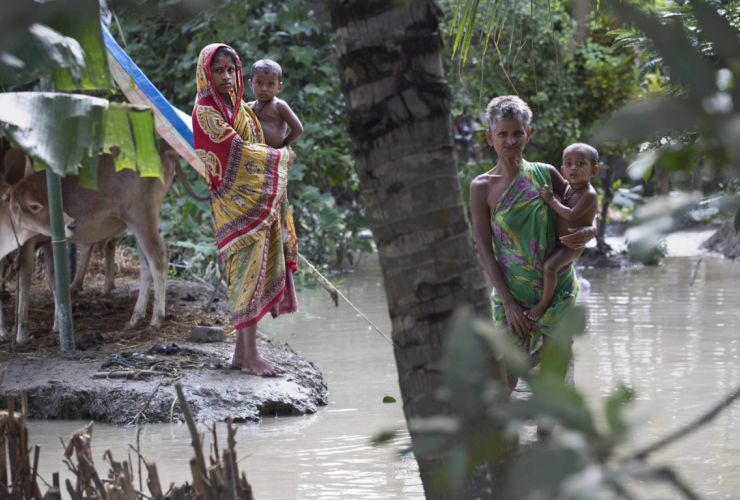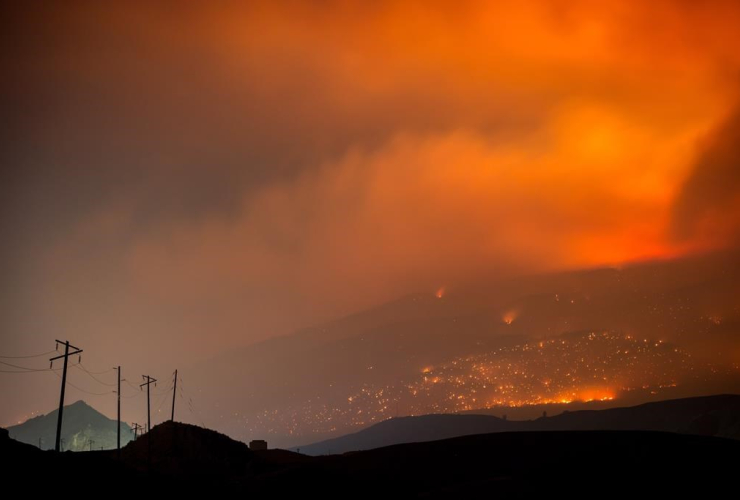What does climate change have to do with economic growth?
Canada’s prime minister and premiers signed a deal in December to “grow our economy, reduce greenhouse gas (GHG) emissions, and build resilience to the impacts of a changing climate.” The Pan-Canadian Framework on Clean Growth and Climate Change outlines plans for carbon pricing, energy-efficient building codes, electric vehicle charging stations, methane emission regulations and more.
Is the framework correct in assuming we can reduce greenhouse gas emissions and grow the economy? If not, which should be given precedence?
These questions come at a pivotal moment in Canadian climate action. The Pan-Canadian Framework marks the first time Canada’s first ministers have endorsed a national plan to tackle climate change. It opens the door to a game-changing carbon price that will make reducing greenhouse gas emissions the smart, cost-saving choice for businesses and individuals.
However, a recent Nature Climate Change article claims, “No major advanced industrialized country is on track to meet its pledges to control the greenhouse-gas emissions that cause climate change.”
Canada pushed for ambitious targets during the 2015 Paris climate negotiations, but even the framework won’t put us on track to meet our pledged reductions.
A five per cent chance of success
Rather than being an outcome of climate action, economic growth may prevent us from reaching climate targets. A July 2017 study in Nature Climate Change concluded that the world only has a five per cent chance of keeping global average temperature from increasing beyond 2°C. On a positive note, the authors found economies worldwide will likely become more energy-efficient, and low-carbon sources like wind and solar will make up a growing share of the mix.
But economic growth will likely cancel out these advances. For every megatonne of emissions reduced through efficiency and clean energy, another megatonne will be produced because of economic expansion. Our economies will get bigger almost as fast as they get cleaner, and emissions will not drop quickly enough to stave off catastrophic climate change.
Economic growth has been the primary goal of every Canadian government, provincial and federal, for decades. Leaders’ speeches are peppered with references to it. Election campaigns are filled with promises of economic expansion. Pity the politician who presides over an economic downturn.
Rarely do we stop to ask what economic growth means. In short, it’s a year-to-year increase in production, distribution and consumption, as expressed by gross domestic product.
If GDP strikes you as a poor indicator of well-being, you’re not alone. The late U.S. politician Robert F. Kennedy once remarked that GDP “measures everything, except that which makes life worth living.” It’s a flawed indicator of progress.

Green growth likely an oxymoron: study
The Pan-Canadian Framework expresses optimism that we can reduce emissions while expanding the economy. This promise of “green growth” is popular because it offers something for everybody. It maintains a commitment to economic growth while claiming greenhouse gas emissions will drop. But, as the Nature Climate Change study asserts, “green growth” is likely an oxymoron.
“Degrowth” advocates argue that tackling climate change requires shrinking the economy. A planned slowdown of the economy would be achieved by implementing shorter workweeks and more holidays and encouraging low-consumption lifestyles.
“Agrowth” advocates such as environmental economist Jeroen van den Bergh argue that we should ignore GDP altogether, and instead evaluate progress using indicators such as literacy, employment, rates of diabetes and heart disease, water and air quality and climate stability. If GDP happens to go up while these indicators improve, so be it. If GDP goes down while other measures of well-being increase, what have we truly lost?
When the Pan-Canadian Framework is implemented, some economic sectors will likely grow. Companies that offer low-carbon energy sources, energy-efficient products and opportunities to offset or store greenhouse gas emissions will prosper. Other sectors, like coal mining for power production, will shrink. We may or may not have “clean growth,” but we will have a cleaner economy and a better shot at preventing or mitigating climate change’s most harrowing effects.
If moving beyond the Pan-Canadian Framework is at odds with growing the economy, let’s make sure our elected officials have their priorities straight. Reducing greenhouse gas emissions should take precedence over economic growth.
— written with contributions from David Suzuki Foundation research fellow Brett Dolter. Dolter is co-editor of the recently released Handbook on Growth and Sustainability.
One sector where the Trudeau
One sector where the Trudeau government is counting on to reduce Canada's global emissions is the LULUCF sector:
"The Land Use, Land-use Change and Forestry Sector reports anthropogenic GHG fluxes between the atmosphere and Canada's managed lands, including those associated with land-use change and emissions from Harvested Wood Products (HWP), which are linked to Forest Land.
In this sector, the net flux is calculated as the sum of CO2 and non-CO2 emissions to the atmosphere and CO2 removals from the atmosphere. In 2015, this net flux amounted to removals of 34 Mt, which, if included, would decrease the total Canadian GHG emissions by 4.7%. New this year, the LULUCF estimates now exclude the impact of significant natural disturbances in managed forests (wildfires and insects), revealing more meaningful trends associated with anthropogenic activities."
(source: Environment and Climate Change Canada, 2017-04-13: "National Inventory Report 1990-2015: Greenhouse Gas Sources and Sinks in Canada - Executive Summary")
From Canada's Second Biennial Report submission to the UNFCCC (April 2006), section 5.1 (footnote):
"Canada has indicated that its accounting for managed forests towards its emissions reductions target will exclude the impacts of natural disturbances because these impacts are non-anthropogenic."
So, the Trudeau administration, contrary to all the research made on the impacts of climate change on Canadian forests, denies the impacts of human activities related to "natural disturbances" (e.g. wildfires, insect infestations such as the mountain pine beetle, the melting of permafrost, soil degradation, drought, etc.)
"In 2011, the managed forests (2/3 of Canada's forests) acted as an overall "net carbon source", releasing 84 million tonnes (Mt) of carbon dioxide equivalent (CO2 eq) to the atmosphere. During the 1990-2011 period, annual emission directly from wildfire ranged from a high of 264 Mt (CO2 eq) in 1995 to a low of 11 Mt in 2000. Canada's managed forests have acted as "net carbon sink" in 11 of the 22 years from 1990 to 2011."
(source: Natural Resources Canada, 2013-12-04: "Carbon emissions/removals in Canada's managed forests")
Under the Kyoto protocol, Canada had the obligation to report GHG emissions from its managed forest sector resulting from natural, or human intervention. As emissions from this sector were going up and were predicted (by federal government scientists) to grow up drastically in the future as a result of a warming climate, the Harper government decided to "not report" emissions from the LULUCF sector to the UNFCCC.
The Trudeau administration goes even further by eliminating completely GHG emissions resulting from "natural disturbances", and showing in its latest National Inventory Report a supposedly "net carbon sink" in the LULUCF sector for the year 2005 and 2009-2015 period. These emissions are not accounted for now, but they might be accounted in the future if Canada's GHG emissions don't go down as expected.
"Climate change is expected mohave a profound impact on the carbon balance Canada's forests. The biggest short-term impacts will result from changes in disturbance regimes. For example, scientists at Natural Resources Canada's Canadian Forest Service predict that the forest area annually burned in Canada is likely to double by the end of the century, resulting in large emissions of carbon.
(source: www.nrcan.gc.ca/forests/climate-change/forest-carbon/13085)
Quebec and Ontario have
Quebec and Ontario have already decided to prioritize Canadian GDP growth over Canadian GHG cuts...via their cap-and-trade link with California. Their modelling showed that it was "cheaper" (in the short run anyway) to pay Californians to cut emissions down there instead.
Sure that causes other problems in the long run for both Canada and those provinces. For example, Canada can't count those cuts towards Paris promises currently. Trudeau needs to convince Trump to give them up from USA ledger, and convince UN to let Canada count them. Plus it leaves Ontario and Quebec still climate polluting at a high level without making the required transition to the economy in time needed.
GDP, first. Safe climate and needed transition, second.






Comments